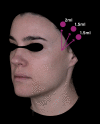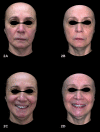Changes in Facial Morphology Using Poly-L-lactic Acid Application According to Vector Technique: A Case Series
- PMID: 35942018
- PMCID: PMC9345188
Changes in Facial Morphology Using Poly-L-lactic Acid Application According to Vector Technique: A Case Series
Abstract
Background: The search for nonsurgical cosmetic procedures has increased considerably in recent years. A new injection technique, using vector direction, has shown good results in improving facial aesthetics but to date has only been performed with hyaluronic acid which can be associated with a risk of vascular complications. Therefore, in clinical practice, it would be interesting to assess this technique with a liquid product already widely used in the facial region, and at the same time bring the same aesthetic benefits, but with greater durability than hyaluronic acid.
Objective: To investigate the improvement of facial morphology in patients with facial flaccidity submitted to the vector technique using poly-L-lactic acid (PLLA) (Sculptra®; Galderma, Lausanne, Switzerland).
Case series: Here we report the outcomes of three cases of female patients, aged between 41 and 55 years, seeking improvement of facial flaccidity. In each patient, PLLA was applied in the posterior temporal region as a bolus, in three points, with a 2-mL injection in the upper region, 1.5mL in the midpoint, and 1.5mL at the bottom point. Each of the three patients showed an improvement in face morphology, with concomitant improvement in the support and stretching of the face and improvement in skin sagging in the upper, middle, and bottom regions.
Conclusion: The vector technique with PLLA is a viable alternative for the treatment of patients with facial skin flaccidity, providing harmonious and progressive improvement in the face morphology.
Keywords: Facial aging; cosmetic techniques; poly-L-lactic acid; vector technique.
Copyright © 2022. Matrix Medical Communications. All rights reserved.
Conflict of interest statement
DISCLOSURES: The authors report no conflicts of interest relevant to the content of this article.
Figures




References
-
- International Survey on Aesthetic/Cosmetic Procedures: Results. 2018;2018:1–49. International Society of Aesthetic Plastic Surgery (ISAPS).
-
- Cosmetic Procedures Performed in 2010. 2010. pp. 1–11. American Society of Aesthetic Plastic Surgeons.
-
- Jacono AA, Malone MH, Lavin TJ. Nonsurgical facial rejuvenation procedures in patients under 50 prior to undergoing facelift: Habits, costs, and results. Aesthetic Surgery Journal. 2017;37:448–453. - PubMed
-
- Hojjat H, Raad R, Lucas J et al. Public Perception of Facial Fillers. Facial Plastic Surgery. 2019;35:204–209. - PubMed
Publication types
LinkOut - more resources
Full Text Sources
